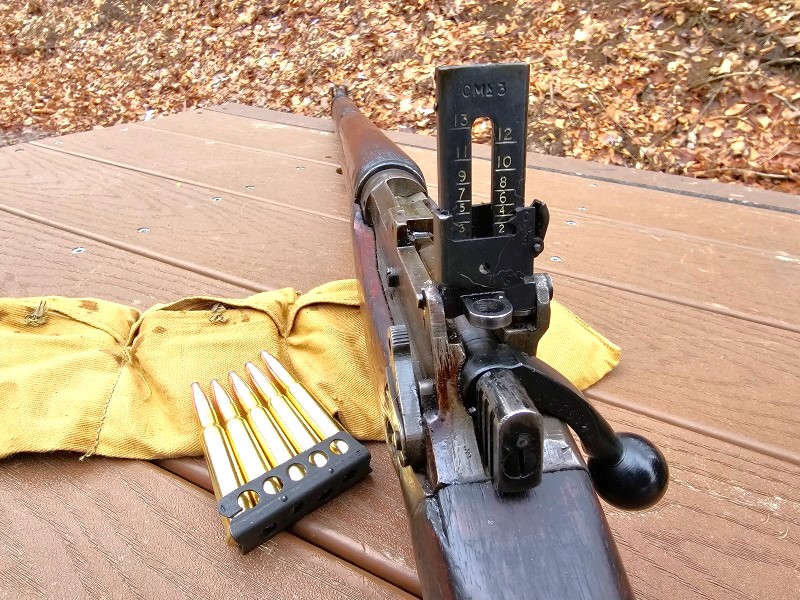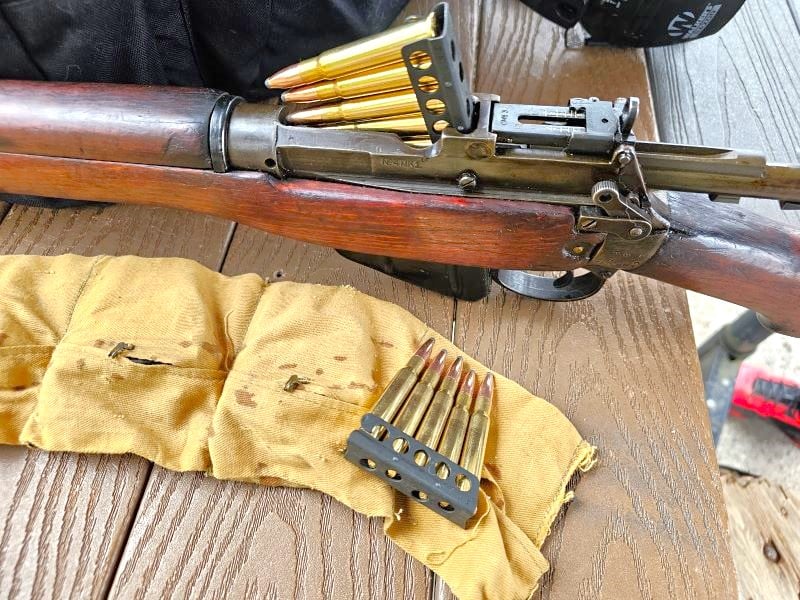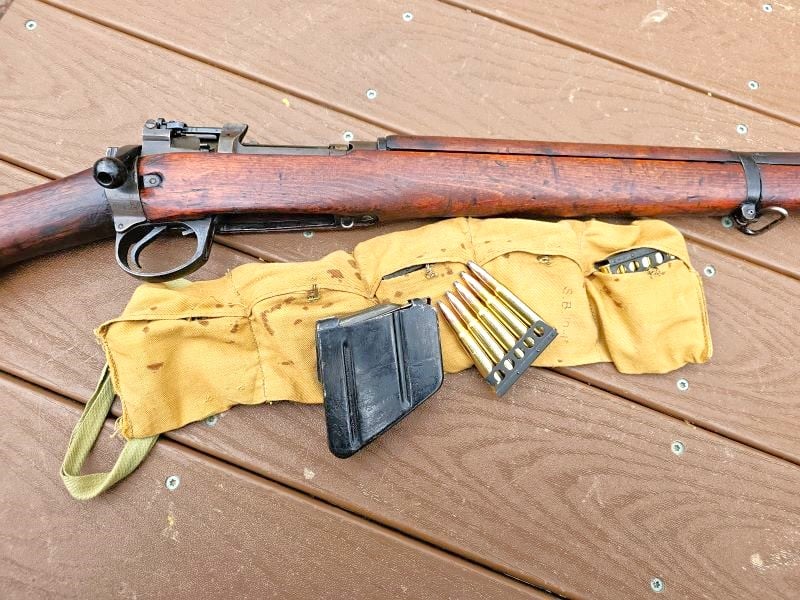From 1895 to 1957, the Lee-Enfield was the standard rifle of the British army. It played a huge role as the main battle rifle in World Wars I and II. It even served in Korea.
I recently took my Lee-Enfield to the range for a bit of Mil-Surp fun, and I thought I’d share my thoughts on the old rifle with you today.
History
Chambered in .303 British, the Lee-Enfield’s history is a long and storied one that proves to be confusing. The British were fond of using various designations of Numbers and Marks. If you watch a video currently that’s narrated by an expert on the subject, it’s not unusual even for the expert to get mixed up on the designations and timeline for the Lee-Enfields, such is the confusion of the lineage.
The Magazine Lee-Metford (MLM) was adopted in 1885 as the last black powder rifle of the British army. It featured a magazine feed and a bolt that cocked upon closing. The MLM went up against the more accurate German Mausers in the Boer War.
The SMLE (Short, Magazine Lee Enfield) replaced the Lee-Metford in 1904, though the Lee-Metford was still used into the 1920s. The SMLE was affectionately dubbed the “Smelly” and featured a 25-inch long barrel. Its overall length of 44.5 inches was considered to be short in those days. Its 10-round magazine was fed by 5-round charger clips. The action had a magazine cutoff that could be activated so the rifle could be fed with single rounds, keeping the magazine in reserve. In case of an emergency, the cutoff was flipped over so the magazine could feed the rife and allow rapid fire.
In 1915, the SMLE was modified into a simpler version that was easier to produce, known as the SMLE MK III. They were made through the rest of WWI, and in 1926, it was redesignated as the Rifle No. 1 MK III. See where things get confusing? And I’m giving you the simplified version here!
But wait – there’s more! From 1922 to 1925, 20,000 SMLE No. 1 MK V rifles were produced. They featured aperture sights that were mounted at the rear of the receiver, giving a longer sight radius and better accuracy, among other changes.
Throughout its history, the Enfield series underwent changes and tweaks to the design. In fact, one could make an entire career out of collecting the various rifles with the various design changes.
No. 4 MK I
Finally, the No. 4 MK I came along and was used throughout World War II and beyond. This one did not have the blunt nose of the SMLE, No. 1, or MK III rifles; rather, it had a heavier barrel that protruded slightly out of the nose.
Sights
The action of the No. 4 was also stronger than on previous models. Several different sighting systems were used, ranging from an L-shaped aperture to a couple of different ladder-type sights. Specifically, there were four different types of sights for these rifles. Three of them involve a flip-up ladder arrangement that, when laid down, supplied the shooter with an aperture sight that was calibrated for 400 yards. One method of raising the sight up the ladder for various ranges (usually from 200 to 1,300 yards) was that of a micrometer, which consisted of a dial that would be turned at the top of the sight, raising or lowering the sight.

Because these sights were labor-intensive to produce, the stop-gap L-shaped sight with two apertures (one for 300 the other for 600 yards) was introduced. There were rifles sitting there finished except for the sight, and this simple sight could be fitted and get those rifles into action far faster than the ladder-style sights.
The next sight was the MK 2 sight. It consisted of the ladder, but instead of the micrometer, there was a small tab on the right side. The tab was spring-loaded and, when pushed in, allowed the sight to be raised or lowered up or down the ladder. The final iteration was the MK 3 sight, which also had the tab, but the forward edge of the tab was curved inward to prevent it from snagging on things (basically, the tab was streamlined). The MK 2 and MK 3 sights were of the stamped variety, whereas the micrometer sights were all machined.
The front sights consist of a post flanked by protective ears, a very simple affair that is drift-adjustable.
Magazine
Each rifle was issued with a single magazine holding ten rounds. Although the magazine is detachable, it wasn’t typical to reload the rifle by doing a magazine change. Rather, the charger clips were used for loading, each consisting of five rounds.

The fact that the magazine holds ten rounds put it far ahead of any other bolt actions on the battlefield at that time. Most bolt actions of the day held five rounds, so the Enfield had twice the capacity. The magazine is robust and well-built.

Safety
The lever-type safety is located on the left rear part of the receiver. Pulling the safety back places the rifle on safe and locks the bolt, preventing it from opening. It also disengages the trigger. It’s a simple safety that works well.
Specs
The No. 4 MK I is 44.5 inches overall and weighs around 9.25 pounds. Its barrel length is 25.2 inches. The bolt handle on this rifle exhibits the hollow that was drilled out to save a little weight. This process was later dropped because it was an extra step and consumed time and resources; in later models, it simply wasn’t done.
The stock of my rifle appears to be made from walnut, and, like all Enfields, it is extremely rugged.
The Caliber
Developed in 1888, the .303 British is 7.7x56R.
The .303 caliber round used in the Enfields during WWII was the MK VII (originally introduced in 1910), weighing 174 grains. Because this ammunition is corrosive, I avoid it like a vampire shies away from garlic. My preference is for non-corrosive ammo because corrosive ammo will attack firearms if not cleaned shortly after shooting them.
Ammunition for the .303 British has become more scarce over the years and certainly far more expensive than I remember from when I owned a couple of Enfields in the 1990s and early 2000s. Then again, in the 1990s, I could buy a No. 4 MK I for between $90 and $110 at my local gun shop. Ah, the good ol’ days.
I located some ammunition made by Prvi Partizan, which is made in Serbia. This ammo is 150-grain soft point, and what I used at the range with the No. 4 MK I. The listed velocity is 2,690 feet per second with this round.
At The Range
Being familiar with the Lee-Enfield, this particular rifle held no surprises for me. Recoil was mild despite the throaty rumble of the report. The rifle’s weight soaks up a good deal of the recoil, and it’s not at all unpleasant to shoot. Especially compared to some of the lighter hunting rifles of present day.

The sights on the No. 4 MK I are good and allow decent accuracy. The first group that I shot was around 3 1/2 to 4 inches at 100 yards, and I was able to tighten that up a little bit. I’ll admit that my eyesight isn’t quite what it used to be, and I’m sure this rifle can shoot more accurately than I can. All in all, though, it’s sufficient accuracy for combat.
I was using the battle aperture sight, which is calibrated for 400 yards, so it was hitting a few inches high at 100 yards.
Final Thoughts
I love old military rifles. Each dent and ding in the stock tells a story that’s richly steeped in history. My mind wanders as to what the rifle might have seen and done throughout its “lifetime.” Who carried it and used it?

Although prices have risen on these older military rifles, they’re still out there if you look around a bit for them. I believe the search is well worth it.
Today’s rifles might be lighter and more accurate; I’ll give them that. But there’s something to be said about a rifle made of wood and steel, that’s substantially built. When you hold one, you know, beyond the shadow of a doubt, that you’re holding something from a long-gone era that was used to free the world from tyranny. It’s something you can’t quite put a price tag on.


